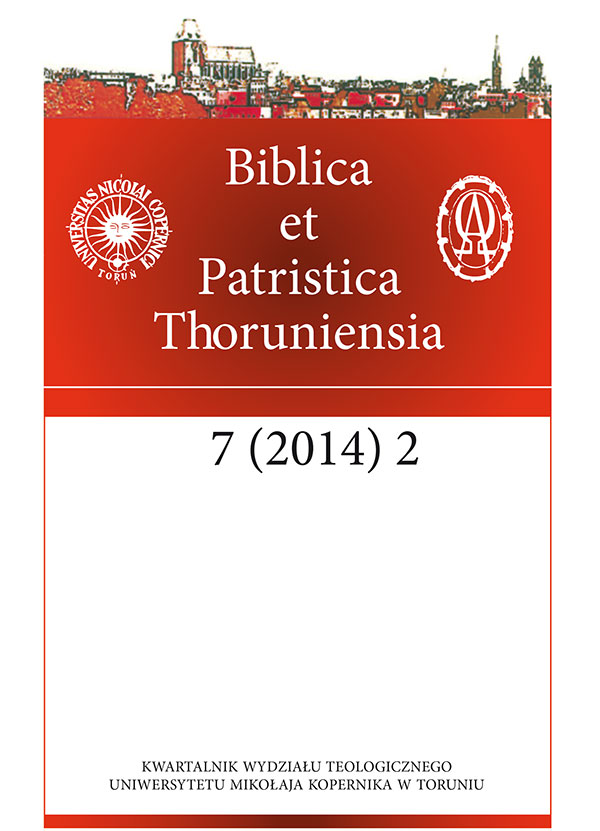Who and why will be “salted with fire” (Mk 9:49)?
DOI:
https://doi.org/10.12775/BPTh.2014.007Keywords
the Gospel of Mark, the journey of Jesus to Jerusalem, the symbolic meaning of fire, the symbolic meaning of saltAbstract
The paper analyses one verse from the speech of Jesus which takes the central place both in the whole Gospel of Mark and in its section dealing with the journey of Jesus to Jerusalem. This context helps to understand the difficult verse as an exhortation to maintain the peace inside the community of the disciples and benevolence towards those outside it, even if it requires sufferings and sacrifices. Various symbolic meanings of fire and salt are also presented, including their connection with the sacrament of baptism.
References
Allison D. Jr, The End of the Ages Has Come, Philadelphia 1985.
Baarda T.J., Mark IX, 49, New Testament Studies 5 (1958–9), pp. 318–321.
Best E., Following Jesus. Discipleship in the Gospel of Mark, Sheffield 1981.
Derrett J.D.M., Salted with Fire: Studies in Texts: Mark 9.42–50, Theology 76 (1973), pp. 364–68.
Donahue J.R., Harrington, D.J., The Gospel of Mark, Sacra Pagina 2, Collegeville 2002.
Evans C.A., Mark 8:27–16:20, WBC 34b, Nashville 2001.
Fields W.W., “Everyone will be salted with fire” (Mark 9:49), Grace Theological Journal 6.2 (1985), pp. 299–304.
Fleddermann H.T., The Discipleship Discourse (Mk 9, 33:50), Catholic Biblical Quarterly 43 (1981), p. 57–75.
Gnilka J., Jezus z Nazaretu. Orędzie i dzieje, Kraków 1997.
Gnilka J., Das Evangelium nach Markus, vol. 1–2, Koln 1979.
Gundry R.H., Mark. A Commentary on His Apology for the Cross, Grand Rapids 1992.
Haręzga S., Jezus i jego uczniowie. Model chrześcijańskiej formacji w Ewangelii według św. Marka, Lublin 2006.
Hauck F., Halas, in: TWNT, vol. 6, pp. 927–947.
Henderson I.H., Salted with Fire (Mark 9.42–50): Style, Oracles and (Socio)Rhetorical Gospel Criticism, JSNT 80 (2000), pp. 44–65.
Kotecki D., “Powołanie pierwszych uczniów” (Mk 1, 16–20) i “nakaz powiedzenia Piotrowi” (Mk 16, 7) jako początek i koniec formacji grupy uczniów w Ewangelii według św. Marka, Theologica Thoruniensia 2 (2001), pp. 29–44.
Lane W.L.,The Gospel of Mark, Grand Rapids–Cambridge 1974.
Lang F., Pyr ktl., in: TWNT, vol. 6., pp. 927–947.
Langkammer H., Jezus wprowadza uczniów w tajemnice swojej śmierci. (Komentarz teologiczny do sekcji ewangelii Marka 8,27–10,45 z uwzględnieniem miejsc paralelnych w ewangelii Mateusza i Łukasza), in: Materiały pomocnicze do wykładów z biblistyki, vol. 3, Lublin 1979, pp. 159–202.
Lattke M., Salz der Freundschaft in Mk 9, 50, Zeitschrift fur die Neutestamentliche Wissenschaft 75 (1984), pp. 44–59.
Lichtenberger H., Pyr, w: EWNT, t. 3, kol. 477–484.
Loska T., Ewangelia według św. Marka, Katowice 1989.
Metzeger B.M., A Textual Commentary on the Greek New Testament, Stuttgart 19942.
Paczkowski M.C., Metafora soli w Biblii i literaturze wczesnochrześcijańskiej, Vox Patrum 60/2013.
Schwarz G., Jesus and Judas, Stuttgart 1984.
Stock K., Boten aus dem Mit-Ihm-Sein. Der Verhältnis zwischen Jesus und dem Zwölf nach Markus, Rome 1975.
Stock K., Il cammino di Gesu verso Gerusalemme. Marco 8,27 – 10,52, Roma 19932.
Strack H.L., Billerbeck, P. (ed.), Kommentar zum Neuen Testament aus Talmud und Midrasch, t. 2, Das Evangelium nach Markus, Lukas und Johannes und die Apostelgeschichte, Munchen 1965.
Wasilewski J.S.,Tabu a paradygmaty etnologii, Warszawa 1989.
Zimmerman H., Mit Feuer gesalzen werden, ThQ 139 (1959), pp. 29–39.
Downloads
Published
How to Cite
Issue
Section
License
CC BY ND 4.0. The Creator/Contributor is the Licensor, who grants the Licensee a non-exclusive license to use the Work on the fields indicated in the License Agreement.
- The Licensor grants the Licensee a non-exclusive license to use the Work/related rights item specified in § 1 within the following fields: a) recording of Work/related rights item; b) reproduction (multiplication) of Work/related rights item in print and digital technology (e-book, audiobook); c) placing the copies of the multiplied Work/related rights item on the market; d) entering the Work/related rights item to computer memory; e) distribution of the work in electronic version in the open access form on the basis of Creative Commons license (CC BY-ND 3.0) via the digital platform of the Nicolaus Copernicus University Press and file repository of the Nicolaus Copernicus University.
- Usage of the recorded Work by the Licensee within the above fields is not restricted by time, numbers or territory.
- The Licensor grants the license for the Work/related rights item to the Licensee free of charge and for an unspecified period of time.
FULL TEXT License Agreement
Stats
Number of views and downloads: 618
Number of citations: 0



